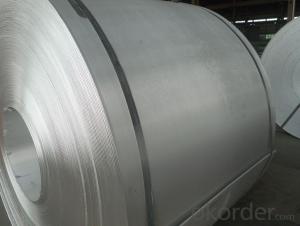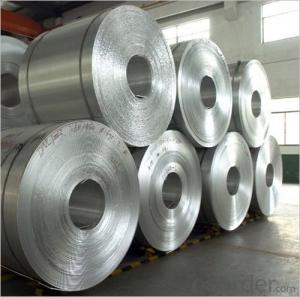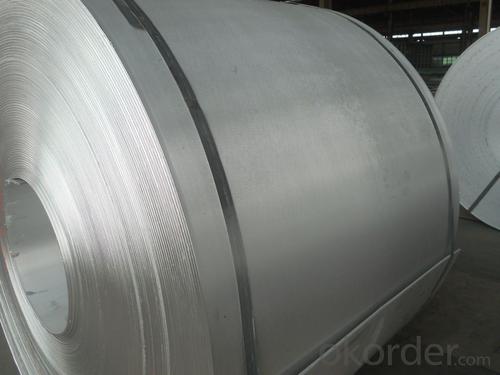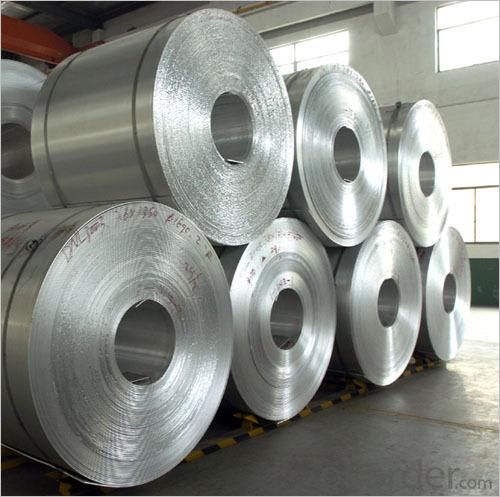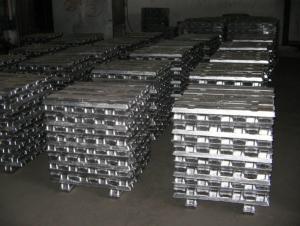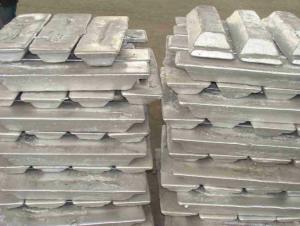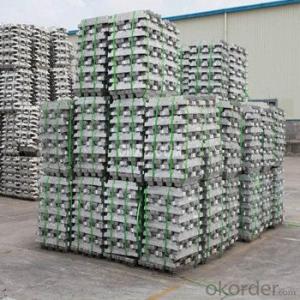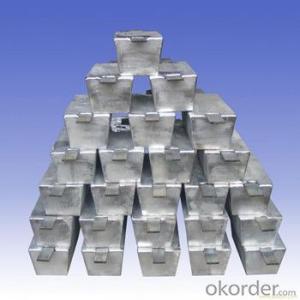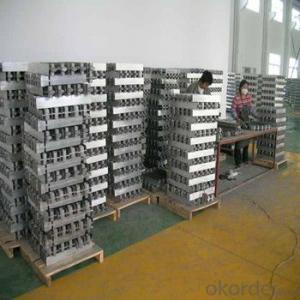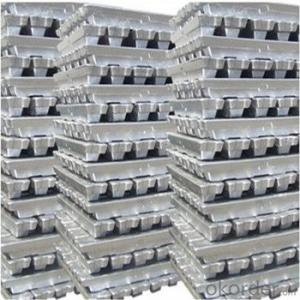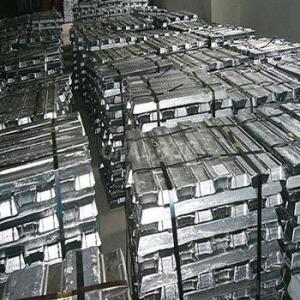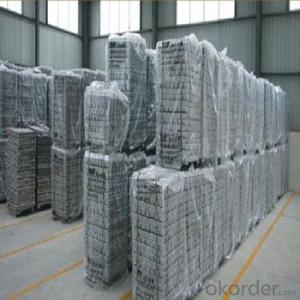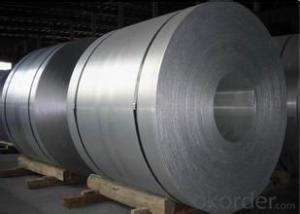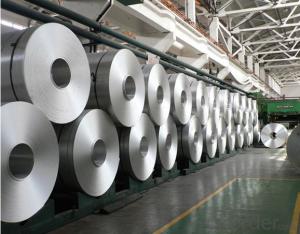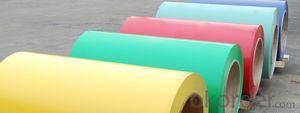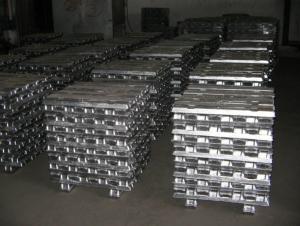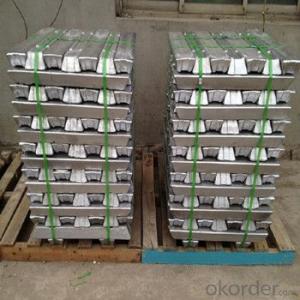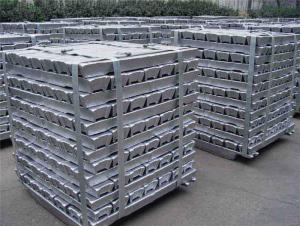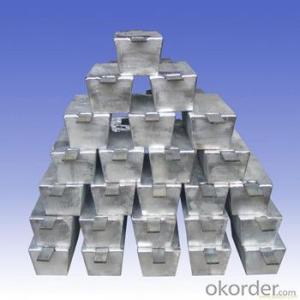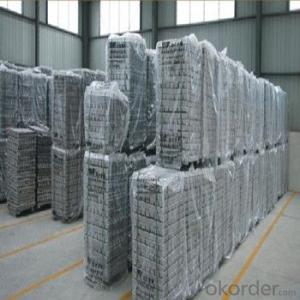Aluminum casting master coil AA1070=P1020 for melt
- Loading Port:
- Tianjin
- Payment Terms:
- TT OR LC
- Min Order Qty:
- 200 m.t.
- Supply Capability:
- 5000 m.t./month
OKorder Service Pledge
OKorder Financial Service
You Might Also Like
Aluminium alloys (or aluminum alloys; see spelling differences) are alloys in which aluminium (Al) is the predominant metal. The typical alloying elements are copper, magnesium, manganese, silicon, tin and zinc. There are two principal classifications, namely casting alloys and wrought alloys, both of which are further subdivided into the categories heat-treatable and non-heat-treatable. About 85% of aluminium is used for wrought products, for example rolled plate, foils and extrusions. Cast aluminium alloys yield cost-effective products due to the low melting point, although they generally have lower tensile strengths than wrought alloys. The most important cast aluminium alloy system is Al–Si, where the high levels of silicon (4.0–13%) contribute to give good casting characteristics. Aluminium alloys are widely used in engineering structures and components where light weight or corrosion resistance is required
Specification:
Alloy: AA1070
Temper: F
Thickness:6mm—100mm
Width: 900mm—2300mm (Can be slitted)
Inner Diameter: 508MM
Coil Weight: AS REQUIRED
Application: MELT FOR LINGOTE TO MAKE ALUMINUM COIL O PLATE
Features:
1. Excellent quality of products
2. Quick delivery
3. Best service to clients
4. BV,SGS avalible
5. No buckle o waveness
6. Tension leveling
7. Certificate of Origin
8. Form A,E,F
Packaging Detail:
Carton ,Wooden pallet with plastic protection packing ,standard seaworthy packing or as your request.
Production Capacity:
Annual Production capacity of 600,000 tons.
Products are exported to United States, Canada, U.A.E, Brazil, Mexico,Thailand, Vietnam, Nigeria etc, over 100 countries and regions all over the world.
Production Line:
CNBM aluminum production base is comprised of 18 aluminum annealers, 10 coil and foil mills, 4 continuous production lines, 2 hot rolling production line and 3 prepainted lines.
FAQ:
1. What is the form of payment?
Normally 30% TT, 100% L
/C AT SIGHT
2. Type of quotation?
FOB, CFR, CIF
3. Port of loading?
Any port in China
4. Delivery time?
30 day after client’s deposit
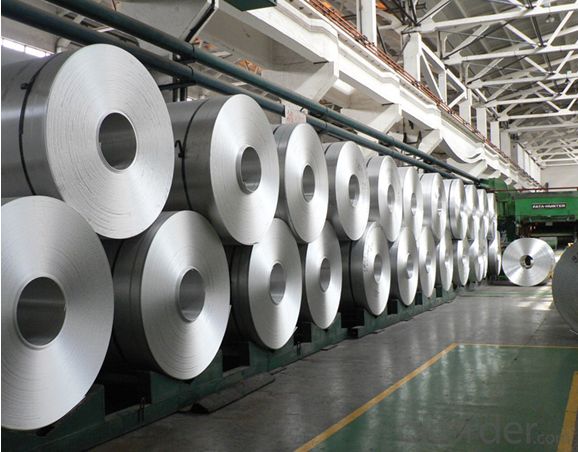
- Q: How do aluminum ingots contribute to the circular economy?
- Aluminum ingots play a significant role in contributing to the circular economy due to their recyclability and multiple applications. The circular economy is an economic system aimed at minimizing waste and maximizing the value of resources by promoting reuse, recycling, and remanufacturing. One key aspect of aluminum ingots is their recyclability. Aluminum is one of the most recycled materials globally, with a recycling rate of around 70-80%. This means that a large portion of aluminum used in various products can be recycled and transformed into new aluminum ingots. This recycling process requires significantly less energy compared to primary aluminum production, resulting in reduced greenhouse gas emissions and a lower environmental footprint. Moreover, aluminum ingots have numerous applications across various industries, including construction, automotive, aerospace, packaging, and electronics. By using recycled aluminum ingots, these industries can reduce their dependence on virgin (primary) aluminum extraction, which is an energy-intensive process. The use of recycled aluminum ingots not only conserves natural resources but also helps in reducing carbon emissions associated with primary aluminum production. Additionally, the circular economy approach encourages the design and production of products with recyclability in mind. Aluminum ingots can be easily melted down and reshaped into various forms, allowing for the creation of new products while maintaining their quality. This closed-loop system ensures that aluminum remains in circulation, reducing the need for raw material extraction and minimizing waste generation. In conclusion, aluminum ingots contribute to the circular economy by being highly recyclable, enabling the transformation of waste aluminum into valuable resources. Their use in various industries promotes sustainability, reduces energy consumption, and minimizes waste, making aluminum ingots an essential component in the transition to a more circular and resource-efficient economy.
- Q: How are aluminum ingots used in the production of medical implants?
- Medical implants utilize aluminum ingots in multiple ways. To begin with, the ingots are melted and formed into specific shapes and sizes, allowing for the creation of a customized base structure that suits the patient's individual needs. Once the desired shape is achieved, the aluminum ingots undergo further processing to enhance their properties. This includes heat treatment, forging, or machining, all of which serve to improve the implant's mechanical strength, durability, and biocompatibility. The malleability of aluminum enables easy manipulation to attain the desired mechanical properties, making it suitable for a variety of implant applications. Furthermore, the performance of aluminum ingots as medical implants is often enhanced through the application of biocompatible coatings. These coatings serve to improve the implant's resistance to corrosion, minimize wear and tear, and facilitate osseointegration, the connection between the implant and the patient's bone. Additionally, the lightweight nature of aluminum ingots is advantageous for medical implants as it reduces the overall strain on the patient's body. This is particularly beneficial for load-bearing applications like hip or knee replacements. In conclusion, aluminum ingots are essential in the production of medical implants, providing a versatile, customizable, and lightweight material that can be processed and coated to meet the specific requirements of each patient.
- Q: What are the advantages of using aluminum ingots in the production of electrical transmission lines?
- There are several advantages of using aluminum ingots in the production of electrical transmission lines. Firstly, aluminum is a lightweight metal, which makes it easier to transport and install compared to other materials such as copper. This reduces the overall costs and effort involved in the construction and maintenance of transmission lines. Secondly, aluminum has excellent conductivity properties, which allows for efficient transmission of electricity. This means that less energy is lost during the transmission process, resulting in higher efficiency and reduced power wastage. Moreover, aluminum is highly resistant to corrosion, which is crucial for outdoor applications. It can withstand harsh weather conditions and environmental factors, ensuring the longevity and reliability of the transmission lines. Additionally, aluminum is a cost-effective option compared to other metals like copper. The abundance of aluminum ore and its relatively low cost of extraction makes it a more affordable choice for large-scale transmission line projects. Furthermore, aluminum is a highly recyclable material, making it an environmentally friendly option. The recycling process of aluminum requires significantly less energy compared to the production of virgin aluminum, reducing carbon emissions and energy consumption. Lastly, aluminum ingots can be easily molded into various shapes, allowing for flexibility in the design and construction of transmission lines. This makes it easier to adapt to different terrain and installation requirements, ensuring the optimal functionality of the electrical grid. In conclusion, the advantages of using aluminum ingots in the production of electrical transmission lines include lightweight, high conductivity, corrosion resistance, cost-effectiveness, recyclability, and flexibility. These benefits make aluminum a preferred choice for the efficient and sustainable transmission of electricity.
- Q: Brief introduction of die casting aluminium ingot
- Application industry and field:1: field: alloy, casting, electronic2, application industry:Light industry, power, electrical, electronic, automotive, machinery manufacturing, construction, packaging and other industries1) in the construction industry, it has been widely applied because of the stability of aluminum in air and the excellent appearance after anodizing2) aluminum alloys are also widely used in the aviation and defense sector;3) in power transmission, aluminum cables are usually reinforced by high strength steel wires;4) kitchen utensils are the earliest use of aluminium, and there is still a vast market today.5) based on its chemical resistance, aluminum is particularly suitable for use in the manufacture and storage of chemicals.6) "aluminum" high affinity for oxygen, which are widely used for deoxidizing agent of iron and steel7) other: automobile manufacturing, container transport, daily necessities, household appliances, mechanical equipment, etc., need a lot of aluminum.
- Q: And aluminum liquid aluminum ingot related industries?
- Alumina is prepared with alumina powder, chlorine and carbon three common reaction. 1953 began to use alumina powder by aluminum chloride, when using fixed bed reactor, fluidized bed reactor after 1977. Compared with fixed bed reactor, the boiling bed reactor has the advantages of short process flow, high chlorine utilization rate, low cost, low labor intensity and small amount of the three wastes.
- Q: What are the challenges in recycling scrap aluminum ingots?
- Recycling scrap aluminum ingots presents various challenges. To begin with, one of the main obstacles lies in the collection and sorting of the scrap aluminum. Due to its utilization in a wide array of products, aluminum can be found in diverse forms and shapes, thereby complicating its efficient collection and sorting. Consequently, the establishment of an extensive and well-organized collection network becomes essential to ensure proper segregation of the scrap aluminum. Another challenge arises from the presence of impurities in the scrap aluminum. Prior to recycling, impurities like paint, coatings, and other contaminants must be eliminated. This necessitates additional processes and treatments to guarantee that the quality of the recycled aluminum meets the required standards. Moreover, the energy-intensive nature of aluminum recycling poses a significant challenge. The recycling process involves melting the scrap ingots at high temperatures, which demands a substantial amount of energy. Managing the associated energy consumption and emissions poses challenges in terms of both cost and environmental impact. Furthermore, the market demand and fluctuating prices of aluminum can create hurdles in recycling scrap aluminum ingots. In some cases, the availability of cheaper primary aluminum makes it more economically feasible to produce new aluminum rather than recycling the scrap ingots. This dynamic can impact recycling rates and the viability of recycling operations as a whole. Lastly, the transportation and logistics involved in recycling scrap aluminum ingots can also be challenging. Gathering scrap aluminum from various sources and transporting it to recycling facilities can be complex and costly. The establishment of efficient transportation networks becomes crucial to ensure the smooth flow of scrap aluminum to recycling facilities. In conclusion, while recycling scrap aluminum ingots offers numerous benefits, addressing several challenges is necessary to ensure a successful and sustainable recycling process.
- Q: How are aluminum ingots used in the production of power transmission towers?
- Aluminum ingots are used in the production of power transmission towers as a key material for constructing the tower structure. They are melted and cast into specific shapes to form the tower components, such as the main support columns, cross arms, and braces. Aluminum's lightweight yet strong properties make it an ideal choice for these applications, enabling the towers to efficiently support the transmission lines while minimizing the overall weight and cost of the structure.
- Q: Want to know the difference between ZL101 and A356 aluminium ingots?
- Like aluminum alloy die-casting material, usually ADC12, of which ADC12 is Japan's aluminum alloy brand. Aluminum Alloy grades and are not as components in China, of course does not mean that there is no such Aluminum Alloy, die casting industry Aluminum Alloy actually ADC12 is representative of the brand, with a state of an industry related to the degree of technological development!
- Q: I would like to ask, aluminum water poured into the mold, what should pay attention to? Aluminum solidification in the mold after the aluminum ingot, how can I get it out?
- One side of the mold is generally provided with a push plate, and the two modules are connected by hinges, and the other end is provided with a clip to prevent the aluminum water from expanding into the cavity.
- Q: What are the challenges in sourcing sustainable aluminum ingots?
- One of the challenges in sourcing sustainable aluminum ingots is ensuring a transparent and traceable supply chain. It can be difficult to verify the sustainability claims made by suppliers and ensure that they are adhering to environmentally-friendly practices throughout the production process. Additionally, there may be limited availability of sustainable aluminum ingots, as the demand for such products may exceed the current supply. Finally, the cost of sourcing sustainable aluminum ingots can be higher compared to conventional options, which can pose a financial challenge for businesses.
Send your message to us
Aluminum casting master coil AA1070=P1020 for melt
- Loading Port:
- Tianjin
- Payment Terms:
- TT OR LC
- Min Order Qty:
- 200 m.t.
- Supply Capability:
- 5000 m.t./month
OKorder Service Pledge
OKorder Financial Service
Similar products
Hot products
Hot Searches
Related keywords
